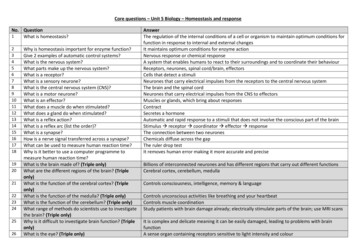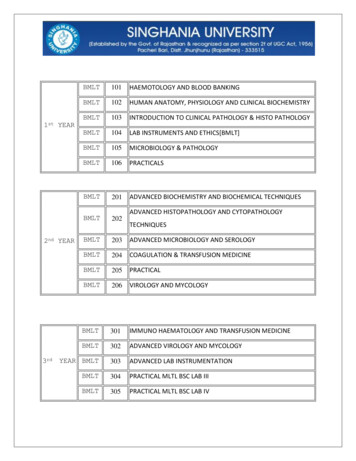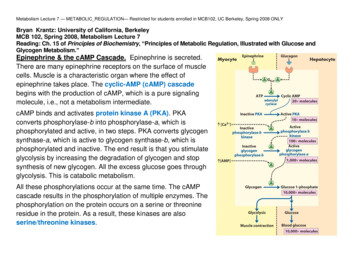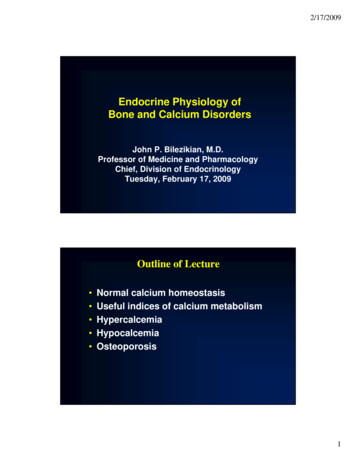
Transcription
Homeostasis1 of 26 Boardworks Ltd 2011
2 of 26 Boardworks Ltd 2011
A day at the saunaHow does the body react to change?3 of 26 Boardworks Ltd 2011
Saving energy?Sayid has decided to save energy by staying in bed all day.How much of his energy do you think this will save?Surprisingly, the answer is only about 30%. The other 70%keeps his body temperature at 37 C, and the fluidsurrounding around his cells at just the right concentration.4 of 26 Boardworks Ltd 2011
What is homeostasis?The body uses so much energy, even during sleep, becauseit must maintain a constant internal environment.This process of keeping things thesame is called homeostasis.Nervous and hormonal controlsystems ensure that the bodymaintains a constant temperature.These control systems also makesure that the body has steady levelsof water, ions and blood sugar.Homeostasis allows the body’s cells and enzymes to work attheir optimum level.5 of 26 Boardworks Ltd 2011
Maintaining internal conditions6 of 26 Boardworks Ltd 2011
Control systems7 of 26 Boardworks Ltd 2011
The organs of homeostasis8 of 26 Boardworks Ltd 2011
9 of 26 Boardworks Ltd 2011
Why control temperature?Environmental temperature isconstantly changing. One minute it canbe very hot, the next very cold.Despite this, the body must be kept ata constant temperature of 37 C.Why?This is the optimum temperature for thebody’s enzymes.Even slight changes in body temperature can have a lifethreatening effect on health. If body temperature falls too low,reactions become too slow for cells to survive: too high, andthe body’s enzymes are at risk of denaturing.10 of 26 Boardworks Ltd 2011
What is core body temperature?The vital organs located deep within the body, such as theheart, liver and kidneys, are maintained at 37 C. This isthe core body temperature.Skin temperature at the body'sextremities, such as the fingersand toes, is usually lower thanthe core body temperature.This reduces the energy lost.On a warm day, skin temperature may be just 1 C lower thanthe core body temperature, but on a very cold day it could beup to 9 C lower.11 of 26 Boardworks Ltd 2011
Measuring body temperature12 of 26 Boardworks Ltd 2011
Finding the right balance13 of 26 Boardworks Ltd 2011
Too hot or too cold?14 of 26 Boardworks Ltd 2011
How is temperature controlled?Body temperature is monitored and controlled by temperaturereceptors in the skin and brain.hypothalamusThese receptors detect changesin the temperature of bloodflowing through those areas.The thermoregulatory centre in thebrain is called the hypothalamus.If body temperature deviates from 37 C, the hypothalamusand skin receptors send out electrical signals that triggeractions or behaviours that increase or decrease heat loss.15 of 26 Boardworks Ltd 2011
Maintaining the core temperature16 of 26 Boardworks Ltd 2011
Why do we shiver?When core body temperature drops, muscles begin to twitch.This rapid contraction and relaxation of the muscles iscalled shivering.Shivering generates heat, which raises bodytemperature.Goosebumps involuntarily appear when aperson becomes cold. Goosebumps arecaused by the tiny muscles at the base ofbody hairs pulling the hairs erect.The upright hairs trap an insulating layerof air, which helps reduce heat loss.17 of 26 Boardworks Ltd 2011
The structure of the skin18 of 26 Boardworks Ltd 2011
Vasoconstriction and warming upWhy do people go pale when they are cold?When core body temperature falls, blood vessels in the skinget narrower. This is called vasoconstriction.Vasoconstriction iscaused by contractionof the muscular wall ofthe blood vessels.This reduces the volumeof blood flowing near theskin surface, andreduces the amount ofheat lost from the body.19 of 26 Boardworks Ltd 2011
Vasodilation and cooling downWhy do people turn red when they are hot?When core body temperature rises, blood vessels in the skinget wider. This is called vasodilation.Vasodilation allows a larger volume of blood to flow near theskin surface, transferring heat to the environment. This coolsthe body down.Additional cooling occurs withthe production of sweat fromsweat glands.As the sweat evaporates ittransfers heat away from the body.20 of 26 Boardworks Ltd 2011
Responding to change21 of 26 Boardworks Ltd 2011
Negative feedback in the body22 of 26 Boardworks Ltd 2011
Thermoregulation: true or false?23 of 26 Boardworks Ltd 2011
24 of 26 Boardworks Ltd 2011
Glossary25 of 26 Boardworks Ltd 2011
Multiple-choice quiz26 of 26 Boardworks Ltd 2011
5 of 26 Boardworks Ltd 2011 What is homeostasis? The body uses so much energy, even during sleep,







